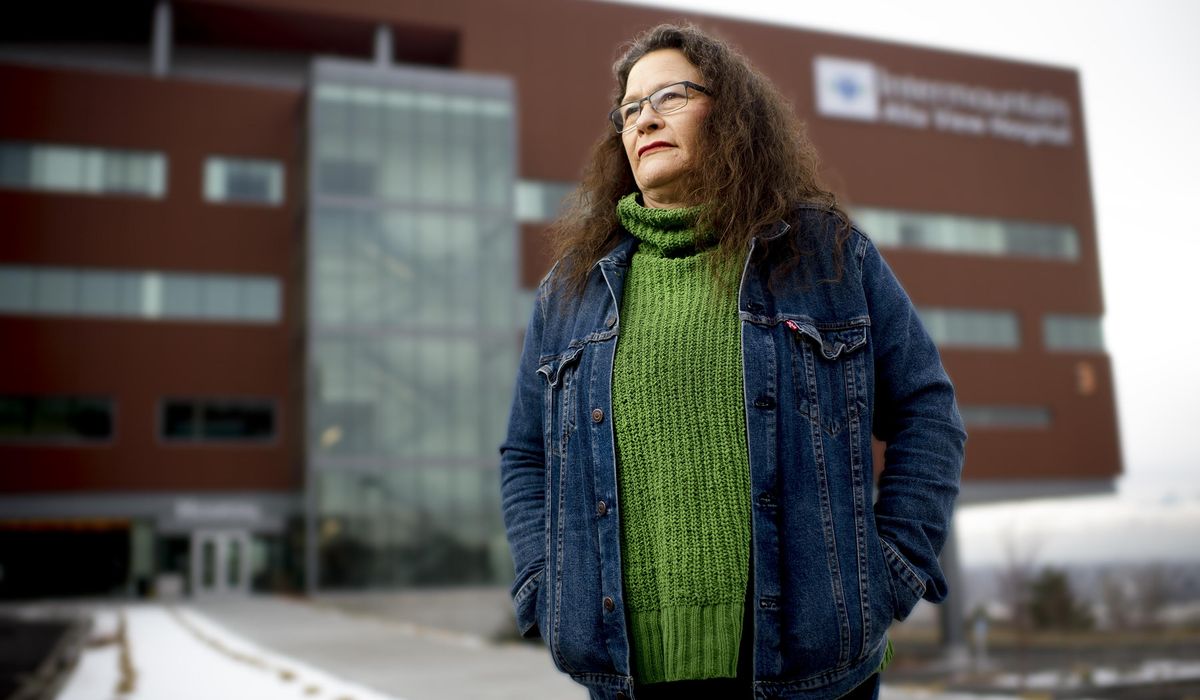PROVO, Utah (AP) – Kim Smith knew from the start that video remote interpreting was going to become a problem.
“I remember seeing that and thinking that is not going to work,” Smith, who is deaf, said in American Sign Language, according to a spoken English interpreter.
Smith is the co-leader of Utah Deaf Hospital Rights, a Facebook group that has gained more than 700 supporters and held a town hall and protest. She is also the president of the Utah Association of the Deaf.
Hospitals nationwide have begun using video remote interpreting, or VRI technology, to fulfill the “reasonable accommodation” portion of the American with Disabilities Act. But with small screens, unreliable Wi-Fi connections and devices that are hard to move around beds, many deaf individuals say that technology has made trying to seek and communicate about medical help worse, not better.
About two to three of every 1,000 children born in the United States have detectable hearing loss, according to the National Institute on Deafness and Other Communication Disorders. Around 15% of American adults report trouble hearing, with hearing loss becoming more common later in life. There are no available statistics on how many deaf individuals use ASL nationwide.
___
Starting a movement
Smith first became aware of nationwide issues with hospitals and interpretation after her mother had a brain aneurysm 22 years ago in Florida. Smith, who was her mother’s caretaker, requested an interpreter. It was denied under the reasoning that her mother, the patient, was hearing.
“I am the communicator in this situation,” Smith said. “I am involved.”
They transferred Smith’s mother to another hospital for surgery, which also denied the request. Without an interpreter, Smith was left in the dark about what was happening to her mother.
“The doctor found that her brain aneurysm was very risky,” Smith said. “It was life or death.”
Smith ended up hiring an interpreter herself in order to know what was going on. She later talked to the hospital’s patients rights representative, explained the situation and was referred to the hospital’s legal team, who eventually made a change in the policy.
Two decades later, Smith said issues are ongoing. She went to the hospital after a head injury in October and specifically asked for an in-person ASL interpreter. She said that staff came back and explained that the interpreting agency they reached didn’t have someone available. Smith pointed out that there are five other interpreting agencies in the area they could have tried calling.
After Utah Deaf Hospital Rights formed, it had a town hall meeting where deaf Utahns began sharing their stories. Smith started hearing from more and more people who had similar situations.
“We have suffered enough,” she said.
In one instance, Smith’s husband went to the emergency room for kidney stones. The hospital used VRI technology, but he was in so much pain he couldn’t look at the screen. Smith said she wound up signing to him what was happening on the screen.
“I should be there to be emotional support to help him as his wife,” Smith said. “Not as the interpreter.”
Writing notes between a patient and a doctor also doesn’t work, Smith said, because ASL and English are two separate languages.
“It is not our native language,” Smith said. “And some words make zero sense to us as deaf people.”
Smith said VRI can be confusing for a deaf patient. The interpreter on the screen can’t see everything that’s happening in a room, and can keep their signing flat even when a doctor appears friendly and cheerful. Interpreters can also be hesitant to vocalize pain, meaning that a doctor doesn’t know the full extent to what a patient is feeling.
“It can be awkward for an interpreter to scream out from the pain they are seeing,” Smith said.
___
Why VRI
When a deaf person who uses ASL comes into Timpanogos Regional Hospital in Orem, it’s the hospital’s policy to use VRI.
“That does meet the needs of the ADA,” said Tim Black, the vice president of human resources and the assistant ethics and compliance officer for the hospital.
Black said it’s against the hospital’s policy for family members or hospital employees to interpret on behalf of a patient. They will also provide an interpreter for a hearing patient’s deaf caretaker.
He said the hospital will try to call the vendor to provide a live interpreter if a patient expresses that they don’t want to use VRI. He points to a couple who gave birth in May who contacted the hospital ahead of time asking for an in-person ASL interpreter to interpret for a new father during a birth.
But getting an in-person interpreter, Black said, can typically take a couple of hours. He said he hasn’t heard a complaint about the hospital’s VRI technology in six years.
“They’re used to it,” Black said. “They’re fine with it.”
The hospital’s VRI equipment is on a cart, which he said is always charged.
The hospital has not had a discussion on if it should hire an in-house ASL interpreter.
“The thing I that I think about the most is just making sure that we are taking care of everyone who comes through our doors with whatever needs they have,” Black said.
___
Fighting for change
Jared Allebest, a deaf attorney who often represents deaf clients in lawsuits, compares using VRI in a hospital room to trying to have a Thanksgiving dinner over Skype. Someone might be able to hear what is going on but they can’t see who is talking or what is going on.
While VRI is good for emergencies, he said it should only be used as a temporary measure until a live interpreter can get to a hospital.
“But that’s not what’s happening,” Allebest said. “Hospitals are relying exclusively on VRI and they are doing everything they can to not hire an ASL interpreter.”
His first lawsuit involved a husband and a wife who delivered a baby without an ASL interpreter present. Since then, he’s filed other lawsuits on behalf of deaf patients.
“It’s a systemic problem,” he said. “It’s not just one client, it’s not just one deaf person. It is happening up and down Utah state.”
He said he’d like for the issues to be settled without lawsuits, but that sometimes it’s the only way to show that there’s a problem.
“Legally, there hasn’t been a clear answer as to what a hospital’s obligations are,” Allebest said.
A live, in-person ASL interpreter, he said, is the gold standard. But hospitals have been sold on the idea that VRI would be the magic bullet. Since the introduction of the technology, he said hospitals have been less willing to bring in in-person interpreters.
“We live in an age where we are fascinated with technology and there are always these upgrades,” he said. “But sometimes the old-fashioned way is the best way.”
Smith would like to see hospitals use live interpreters in emergency situations and to provide ASL interpreters for the deaf family members and caretakers of hearing patients. She wants hospitals to reach out to the Utah Association of the Deaf to create partnerships and learn about communication and cultural differences.
In the time since Utah Deaf Hospital Rights has launched, she’s gotten messages from deaf patients who are at hospitals and are not being provided with an interpreter.
“I just want to make sure that everyone knows that we are not second-class citizens,” Smith said. “We are real people that have all of the skills in life except for the ability to hear.”















